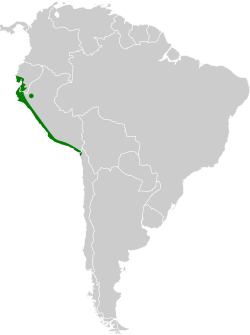Distribution and habitat
The short-tailed field tyrant is found from Santa Elena and Guayas provinces in west-central Ecuador south for the entire length of Peru. It also occurs separately in northern Peru's Marañón River valley. There are isolated records further north in Ecuador, one record in Colombia, and a few records in far northern Chile. The species primarily inhabits a variety of open landscapes including arid scrublands, agricultural areas, and pastures. There are some records in woodlands. In elevation it ranges from sea level to 1,500 m (4,900 ft) in Ecuador and to 1,200 m (3,900 ft) in Peru. [6] [7] [8]
Behavior
Movement
The short-tailed field tyrant is a year-round resident. [6]
Feeding
The short-tailed field tyrant feeds on insects, though details are lacking. It typically forages singly or in pairs, and almost entirely on the ground. It stands and walks upright, flicking its wings and tail. It takes prey from the ground or with leaps or short flutters to catch it in mid-air. [6] [7] [8]
Breeding
The short-tailed field tyrant breeds between February and June in Ecuador; its season in Peru is not known. Its nest is an open or partially domed cup made from coarse grass lined with finer grass. It is placed on the ground, usually in a grass clump or under a shrub, though sometimes in the open. The clutch is three to five unmarked white eggs. The incubation period is about 14 days and fledging occurs 13 to 14 days after hatch. Details of parental care are not known. There is one report of a nest having been parasitized by a shiny cowbird (Molothrus bonariensis). [6]
 | Songs and calls
|
Vocalization
One description of the short-tailed field tyrant's song is "a weak, sibilant tizztízzz, sometimes preceded by a few tik notes". [7] Another is "a series of dry, metallic tik or spit notes followed by a buzzy, rising-falling trill: tik tik tik tzzZZZZzzew". Its calls include "a metallic, dry spit! and, when flushed, a sputtering trilled series of spit and trr notes". [8] The species sings from a low perch or during a flight display that may take it 20 m (70 ft) into the air. [7] [8]
This page is based on this
Wikipedia article Text is available under the
CC BY-SA 4.0 license; additional terms may apply.
Images, videos and audio are available under their respective licenses.




